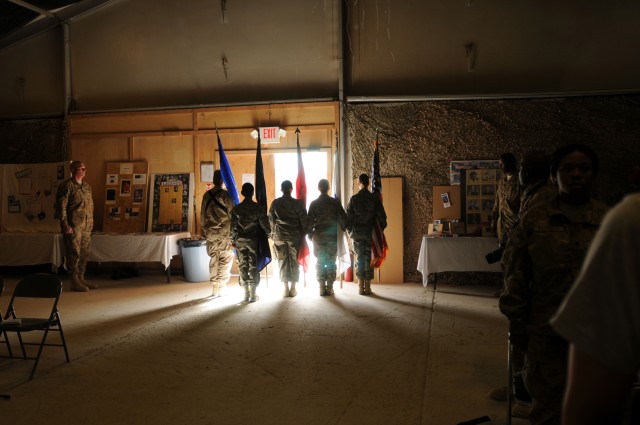KANDAHAR AIRFIELD, Afghanistan (Mar. 19, 2011) - The movements that have so greatly influenced the growth of women's roles in today's society were celebrated in a Women's History Month observance put on by the Equal Opportunity Advisors from Regional Command-South here Mar. 18.
The event highlighted five particularly notable movements that influenced women's history: the Labor Movement, the Women's Suffrage Movement, the Civil Rights Movement, the Women's Rights Movement and the Environmental Movement.
"The significance of this event is to make people aware of the roles women have played in our American history," said Master Sgt. Earl Edmund, the RC-South EO Non-Commissioned Officer in charge. "We are here to educate folks on those events. We have women who've been in the military - women who, before the military started taking females, played a part in the wars - dressed as males, so they would not be discovered. They were spies, nurses, doctors, mechanics and so forth."
According to Army.mil, women have been serving in the U.S. Army since 1775 as nurses, cooks and laundresses. Women's roles in the military changed after the Vietnam War. In 1972, all military occupational specialties opened to women, both enlisted and officer, except for those requiring combat duty.
Women have been mechanics since World War II, said Col. Tamara Averett-Brauer, the Air Force commander of the 451st Expeditionary Aeromedical Evacuation Squadron and the guest speaker at the event.
"These were women who had to prove themselves as maintainers and introduced the little red wagon as a way to carry the heavy tool box, but who came to be valued and respected particularly when the guys found out that their smaller hands could reach some areas that the men's hands couldn't."
Pfc. Keyata Abbitt, a mechanic tasked out as a Supply clerk for 563rd Aviation Support Battalion, 159th Combat Aviation Brigade, 101st Airborne Division, said that even in her lifetime, she's seen women's roles grow in the military.
"I'm an Army brat," she said. "When I would go to the bases, I would see mostly males. Now you see (as many) females as males. You see more females gaining rank. You see more females doing different jobs."
Although Women's History Month is formally recognized nationally in the United States and United Kingdom, the women featured at the booths at the event were from international backgrounds.
"This is to educate ... people from all different backgrounds about the part that women have played in developing our country, not only in the military, but in science, in the medical field (and) in the economy as a whole," said Edmund. "We are not celebrating only American women. We are celebrating women from all over the world."
"This event is an opportunity to recognize the journey women have had to where we are today in our society. It helps us understand where we came from and to appreciate those who went ahead of us and paved the way to let us do the things we do now," said Averett-Brauer.




Social Sharing